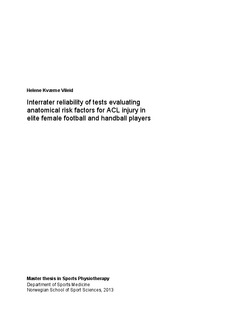| dc.description.abstract | Background: A cohort was set up at the Oslo Sports Trauma Research Centre in 2007
aiming at investigating risk factors for anterior cruciate ligament (ACL) injuries in elite
female football and handball players. The reliability and measurement error of the tests
included in the cohort has not been established for this sample.
Objective: To test the interrater reliability of a series of tests evaluating anatomical risk
factors for ACL injury in elite female football and handball players. The anatomical risk
factors are generalized joint laxity (GJL), genu recurvatum, knee laxity, hip anteversion
and 12 anthropometric measures.
Methods: A protocol was designed for establishing interrater reliability of the following
anatomical measures: generalized joint laxity (GJL), genu recurvatum, knee laxity, hip
anteversion and 11 anthropometric measures of the lower limbs and height. The players
were tested and retested on two separate days with intervals varying between 2−51 days.
Reliability was assessed using a set of statistical tests; intraclass correlation coefficients
(ICC2.1), root mean square error (RMSE), paired t-test, Wilcoxon signed rank test and
Bland-Altman plots.
Results: 42 female athletes (22 football and 20 handball players) were included. Mean
± SD age, football players: 21.1 ± 3.2 and handball players: 21.9 ± 4.4. The interrater
reliability was moderate for measures of knee laxity on the right side, ASIS width, and
bilateral tibial and femoral widths (ICC2.1 0.55−0.65). Low interrater reliability was
found for knee laxity on the left side, bilateral genu recurvatum, hip anteversion on the
left side, bilateral tibial and femoral widths and femoral-tibial ratio on the right side
(ICC2.1 0.29−0.44). Femoral-tibial ratio on the left side and hip anteversion on the right
side showed little if any correlation (ICC2.1 0.17−0.22). Measuring height had the
highest correlation (ICC2.1 0.99). The GJL showed no difference between the two days
of testing.
Conclusion: The interrater reliability of the anatomical tests included in this study
varied from little to very high reliability. A greater variance of the sample, continuous
variables, double-blinding, intrarater testing prior to the study, better piloting and better
training of the testers are alterations that might have improved the results of this study. | no_NO |
